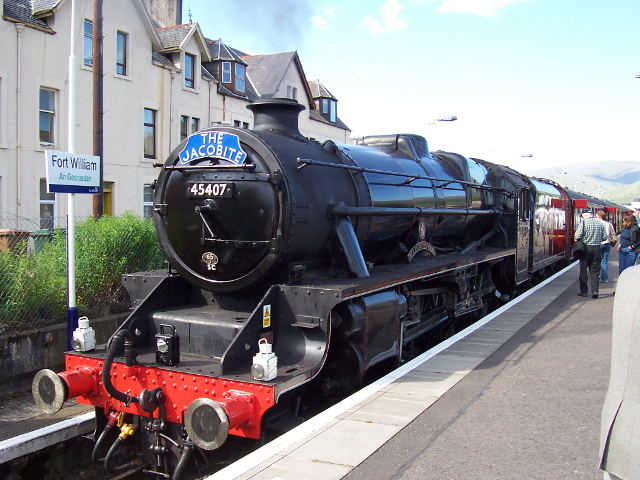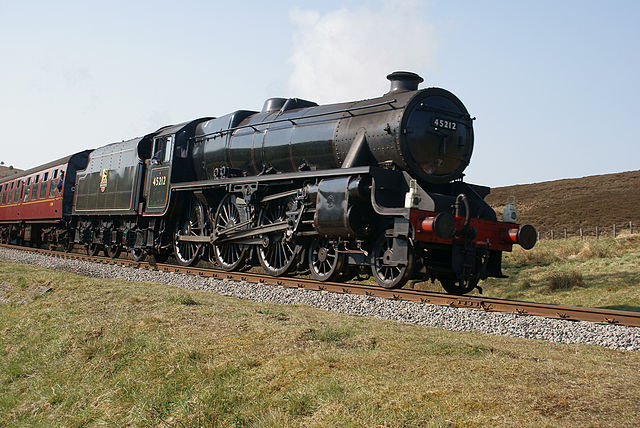Part 20: Interlude: Stanier 'Black Five'(Paul.Power)


Sources: myself, Wikipedia, cooldudeandy01, The Rev W. Awdry, C. Reginald Dalby.
Stanier Black Five 5P5F/5MT
Company: London, Midland and Scottish Railway (LMS), and later British Railways (BR)
Designer: William Stanier
Wheel Arrangement: 4-6-0
First produced: 1934
Total built: 842(!)
Total preserved: 18 (+ 1 fictional)
Eight hundred and forty two. Only three other British locos beat that total: number 3 is Stanier's 8F heavy freight class, which topped out at 852, chiefly because of its use as the standard engine of choice during the first half of World War 2. Number 2 is the 863 examples of the GWR's 57xx class, which TT veterans will recognise as the Collett Pannier Tank (or possibly Kirby Paul Tank) - you know, the one that's like a Jinty but slightly better. Number 1 is the 957 DX Class 0-6-0 goods engines of the London and North Western Railway, all of which were sadly scrapped. Either way, 842 is still a heck of a lot of locomotives. So let's talk about them.
Superficially, the Black Five looks very similar to the Jubilee: same wheel arrangement, same general shape. There are a few differences: the Black Five was a little lighter than the Jubilee, had a slightly lower boiler pressure, only two cylinders instead of three, and smaller driving wheels. The smaller driving wheels in particular are of interest, because throughout the history of loco design there's a general rule of thumb: passenger engines have fewer, bigger driving wheels, freight engines have more, smaller driving wheels. Mechanically, this translates into more speed for the passenger engines, and more driving force for the freight engines.
Of course, the Black Five's wheel's are in between - because they are mixed traffic engines. The mixed traffic engine was a fairly new concept at the time, introduced with the GWR's "Hall" class, but the general concept is of a locomotive that can do anything - barring particularly express passenger (although the Black Five could still top out at around 90mph) or heavy freight work - and, ideally, go anywhere - which, with decent weight, length and axle loadings, the Black Five could also handle. They were really useful engines. That's why there were 842 of them, with production continuing into BR days.
And speaking of Really Useful Engines...
 . Well, I already did it for Gordon, so Henry deserves his spot in the sun too. Not that he started life as a Black Five. No-one's quite sure what he started life as, except possibly a nuisance. But following his accident with The Flying Kipper (look it was a train that transported fish, all right), he got sent to Crewe (the LMS's main locomotive depot, which produced many Black Fives itself) for a rebuild and emerged as something that was mostly a Black Five.
. Well, I already did it for Gordon, so Henry deserves his spot in the sun too. Not that he started life as a Black Five. No-one's quite sure what he started life as, except possibly a nuisance. But following his accident with The Flying Kipper (look it was a train that transported fish, all right), he got sent to Crewe (the LMS's main locomotive depot, which produced many Black Fives itself) for a rebuild and emerged as something that was mostly a Black Five.The real world reason for this? C. Reginald Dalby, the illustrator of the first eleven Railway Series books, was - while a genius at backgrounds and nice, clean lines - kind of bad at drawing at consistently drawing trains. Yeah, bit of a drawback in his job. Henry in particular spent way too much time looking like Gordon, not least because in books 2 though 5, he was coloured blue. Returning him to green livery and giving him a new shape was the Rev W. Awdry's plan to help differentiate Henry from Gordon. Ultimately, relations between Awdry and Dalby broke down enough that Dalby left and John T. Kenny came in as the new illustrator for books twelve to seventeen - he may not have been as good at backgrounds as Dalby, but his engine-drawing ability and working relationship with Awdry were much better.
Anyway, yeah. Black Fives. A "deuce of a good engine", as Stanier himself described them, and some of them soldiered on to the end of BR's steam traction in 1968, pulling the "15-guinea" specials that marked the end. 18 of the 842 survived into preservation, and 13 of those have seen work since then.